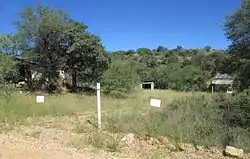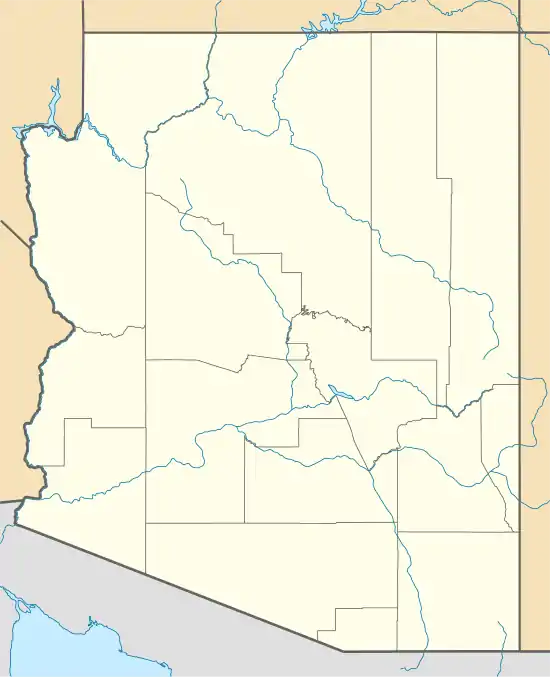Duquesne, Arizona | |
|---|---|
 Adobe ruins in Duquesne. | |
 Duquesne, Arizona Location within Santa Cruz County  Duquesne, Arizona Duquesne, Arizona (the United States) | |
| Coordinates: 31°22′16″N 110°41′09″W / 31.37111°N 110.68583°W | |
| Country | United States |
| State | Arizona |
| County | Santa Cruz |
| Time zone | Mountain (MST) |
| Post Office opened | June 6, 1890 |
| Post Office closed | February 14, 1920 |
Duquesne is a ghost town[1] in the Patagonia Mountains in eastern Santa Cruz County, Arizona, near the international border with Sonora, Mexico. The town, which is currently under private ownership and closed to the public although the roads are almost all public, was once the headquarters of the Duquesne Mining and Reduction Company and is the site of the Bonanza Mine. Washington Camp is approximately one mile northwest of Duquesne and was where the mine's reduction plant was located.[2]
History
American prospectors in the Patagonia Mountains had established claims in Washington Gulch as early as the 1860s, but recurrent Apache raids prevented the area from being fully developed until the 1890s. Washington Camp was the older of the two towns and had been the site of a post office since 1880. Duquesne was founded ten years later in 1890, a year after George Westinghouse of the Westinghouse Electric Company bought up a majority of the Patagonia claims and organized the Duquesne Mining & Reduction Company to begin large-scale production. On June 6, 1890,[1] the post office in Washington Camp was closed and moved to Duquesne, which was also the location of the company headquarters and the Bonanza Mine. Major production began in 1912 and lasted until 1918, with total production at more than 450,000 tons of zinc, lead and copper ore and silver as a byproduct.[2][3]
During its heyday, Duquesne boasted 1,000 residents, several businesses and numerous homes, one of which was a large Victorian frame house belonging to George Westinghouse.[1] The home still stands, although in disrepair. Other remains include a smaller frame house, a boarding house and brothel, an adobe commercial building and an old cemetery. The schoolhouse was located in between Duquesne and Washington Camp, to serve the students of each community, but has since been demolished. The site is now occupied by a modern A-frame cabin. There is also the ruins of various mining operations in the surrounding hills.[2]
A few residences remain in Duquesne and Washington Camp, although the post office has been closed since 1920.[1] Signs are posted against trespassers.[4] There are other ghost towns in the area as well, including Harshaw and Mowry to the north and Lochiel just to the southeast, along the border with Mexico.[2][3]
Photo gallery
 George Westinghouse (1846–1914)
George Westinghouse (1846–1914) The Westinghouse Estate.
The Westinghouse Estate. Inside the Westinghouse Estate from the kitchen window.
Inside the Westinghouse Estate from the kitchen window. The commercial building.
The commercial building. The ruins of what may have been the assay office.
The ruins of what may have been the assay office. The boarding house and brothel.
The boarding house and brothel. A small frame house.
A small frame house. The remains of an old car near the little house.
The remains of an old car near the little house. A large adobe building that was once part of the Bonanza Mine.
A large adobe building that was once part of the Bonanza Mine. An ore chute at the Bonanza Mine.
An ore chute at the Bonanza Mine.
See also
References
- 1 2 3 4 Sherman, James E. & Barbara H. (1969). Ghost Towns of Arizona. University of Oklahoma. ISBN 0806108436.
- 1 2 3 4 John and Bette Bosma (April 2006). "Southwest Arizona Ghost Towns Harshaw, Mowry, Washington Camp, Duquesne, Lochiel" (PDF). Retrieved January 10, 2015.
{{cite journal}}: Cite journal requires|journal=(help) - 1 2 "Legends of America: Patagonia Back Road Ghost Towns". p. 2. Retrieved January 10, 2015.
- ↑ Varney, Philip (1980). "Nine: South of Sonoita". Arizona's Best Ghost Towns. Flagstaff: Northland Press. pp. 99–100. ISBN 0873582179. LCCN 79-91724.
External links
- Duquesne – Ghost Town of the Month at azghosttowns.com
